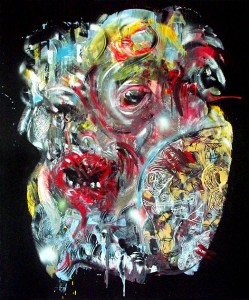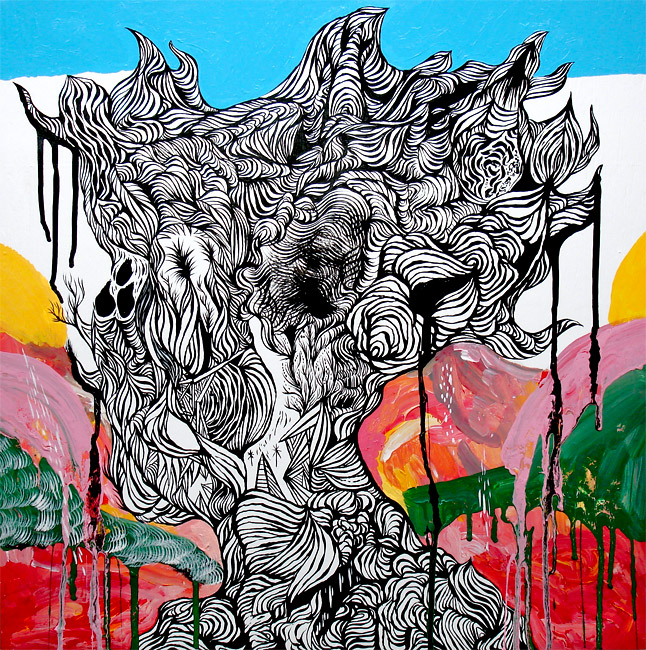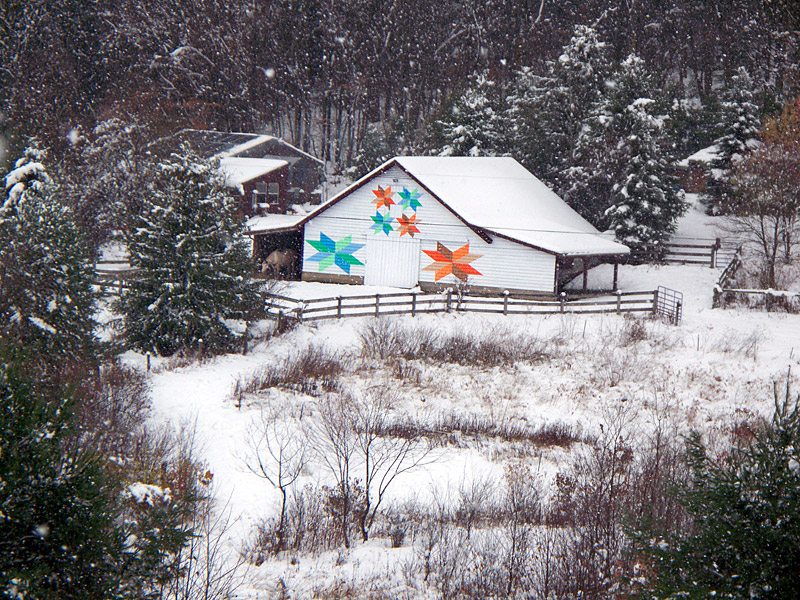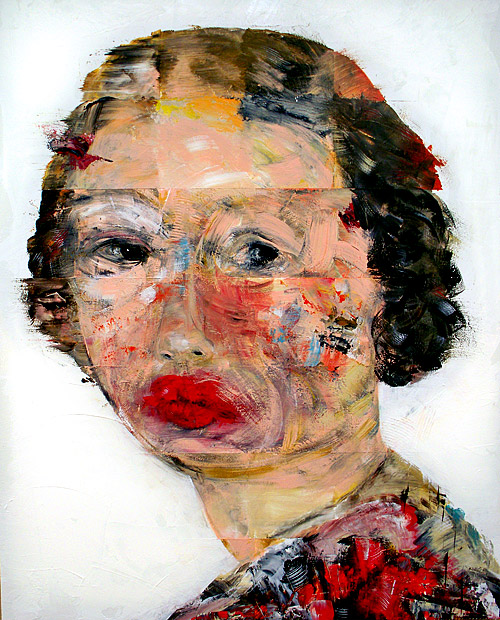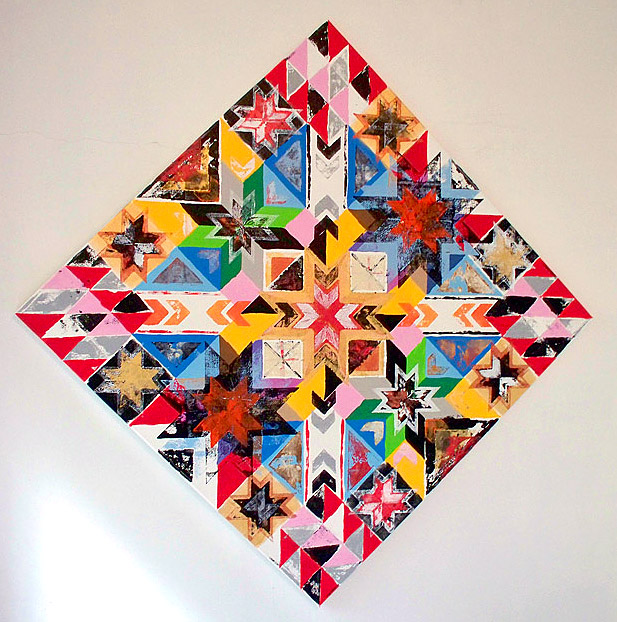This is the first in an occasional series of interviews with visual artists. I’m interested in the work people do in media other than writing, and often find inspiration there, so I want to reach out to those people and, as best I can, talk to them about their ideas and work. I met Bill Dunlap at the Virginia Center for Creative Arts in 2006; we’ve stayed in touch since. I’m a huge admirer of his paintings and drawings and have wanted to talk to him about his art for a while now. I’m really happy he took the time to answer my questions. More of Bill’s work can be found at www.billdunlap.com
Can you talk a little bit about the line—I’ve followed your work for some time now, and have noticed the importance of lines in your drawings (obviously) but also your paintings, many of which are intricate linear systems. In some of your later paintings (I’m thinking your ‘Black Paintings’) the absence of lines seems to be important, that lines are deliberately smudged. And, in your newer work, the quilt-inspired stuff, you seem to be back to lines, but simpler geometric shapes. Perhaps this is just the influence of illustration on your work, but it seems like more than that–I wonder, too, about your interest in music and writing—mediums also fundamentally built from lines.
I’ve thought that if an artist has some affinity for line, then the work tends to look more like graphics, decoration, illustration – often with areas of solid color. On the other hand, if an artist has greater interest in tone or shading the work tends to look more painterly, “realisticâ€. This is true even for drawing: line drawers tend to make discrete outlined scenes and figures, while tone drawers use shading to make more rounded-out objects emphasizing changes in light. Line work tends to be bolder and more immediate, shaded work tends to be more mysterious. Grosz and Goya, two of my favorite artists, embody these differences. Grosz’s drawings from around WWI are a kind of genius stick figure drawing that has always amazed me. I continue to marvel at how much power he achieves with such an economy of means. Goya’s etchings (The Disasters of War, especially) use loads of cross-hatching, stippling, washes, and other effects to achieve their dark chiaroscuro. The ambiguity of scene and lighting adds to the terror of the compositions.
So I’ve often thought how these two extremes could play out in my own work. I’ve found that it tends to be either/or. When I work in a way where lines are dominant, tonal changes and lighting don’t seem to play much of a role. At times I can combine the two styles, but currently I’m feeling that those works have a kind of add-on quality that I’m not so interested in right now. Usually, the way they come about is that I do a rather loose “painterly†thing, then lay out areas of line work on top of the paint areas. Lately, I’ve come to feel that those pieces have a kind of “futzing around†quality to them, as if I do something spontaneous, then start doodling on top of it. If the spontaneous areas were truly strong, they wouldn’t need the decoration on top. This has led to how I’ve been doing the black paintings lately. I try to use no lines at all, but still they show up now and then. I think of those lines as being more functional, rather than decorative.
You’ve been painting barns—how did that come about? Why barns? Will you do more large-scale outdoor stuff? The barn murals seem in some ways to be an extension of your smaller work on wood, in which you play with the shape of the ‘canvas,’ where paintings become sculptures. Do you see the murals as decorative, or transformative? Some of the murals encompass the building—they feel more like sculptures than paintings, that the barn isn’t simply decorated, but changed into something else.
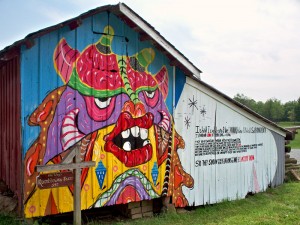 The barns have come my way by a great opportunity given to me by John Shipman, gallery director at the University of Maryland. The idea was to put contemporary painting onto rural structures across the state of Maryland. I’ve come to think of my painting on barns as a way of extending two existing folk art traditions that have strong presences in this geographic area – tobacco barn painting (specifically the Mail Pouch barns) and quilting. The Mail Pouch barns have a way of personalizing the landscape. People will go out of their way just to see them. I like also that the Mail Pouch barns are not, for the most part, being maintained. They’ve become weathered ruins from an earlier time. As for quilting, it has generally been small-scale and on fabric. To take those great forms and patterns from quilting, and to render them 20 feet tall outdoors is a way of valorizing a part of the long-existing culture of this area. I think it also stresses the strength of those quilting forms, the stars and patterns. When I see them painted at that scale they become powerful and mysterious.
The barns have come my way by a great opportunity given to me by John Shipman, gallery director at the University of Maryland. The idea was to put contemporary painting onto rural structures across the state of Maryland. I’ve come to think of my painting on barns as a way of extending two existing folk art traditions that have strong presences in this geographic area – tobacco barn painting (specifically the Mail Pouch barns) and quilting. The Mail Pouch barns have a way of personalizing the landscape. People will go out of their way just to see them. I like also that the Mail Pouch barns are not, for the most part, being maintained. They’ve become weathered ruins from an earlier time. As for quilting, it has generally been small-scale and on fabric. To take those great forms and patterns from quilting, and to render them 20 feet tall outdoors is a way of valorizing a part of the long-existing culture of this area. I think it also stresses the strength of those quilting forms, the stars and patterns. When I see them painted at that scale they become powerful and mysterious.
As for thinking more in sculptural terms, of using the architecture of the barn to drive the design of the painting, I try to do that whenever possible. When a barn is just a flat rectangle it becomes more difficult. For some time now there has been a growing movement of “quilt barnsâ€. Some of these I like a lot, but almost always they are sort of add-ons that are not at all integrated with the barn. They way these are done is that the artist paints on sheets of plywood in a studio somewhere, then takes the finished panels to the barn and has them bolted onto the surface. I want my barn paintings to be directly on the barn and to use the architecture of the barn as much as possible. When I’ve been successful at that I’ve been able to use the peaks, doors, and lines of the siding to strengthen the design. I like what you say about transforming the barn, rather than merely decorating it.
How do you feel about graffiti?
I guess I’d say I’m of several minds regarding graffiti. A good friend of mine has written the standard work on the history of American graffiti, and he is a great graffiti artist and muralist. I respect him as a writer and artist, but I don’t know if we agree on much regarding graffiti. To get to the heart of it, I find tagging very often (but not always!) ugly, obnoxious, and selfish. Taggers often cover up information that is intended for safety, or that would be helpful to lost people or people with disabilities. I admire the letterforms of great graffiti writers, but I don’t really understand the point of writing one’s name over and over. I heard someone criticize graffiti writers once by saying: “You writin’, but you ain’t sayin’ anything.†Also, there are qualities of predictability, competition, and ego in graffiti that don’t much appeal to me. I pursue art to try to get free of those things.
But, having said all that, I still do graffiti pretty often. I find it fun to surprise people with big, anonymous, unexpected pieces in public spaces. I’ve developed my own sort of code of ethics on how I work on walls in public spaces. I will not paint on an unpainted, graffiti-free wall. I love the look of old stone or concrete walls, especially when they’ve been weathered or stained with water. I will only paint on a wall that is already covered pretty heavily with graffiti or that has a coat of paint on it. Sometimes public agencies cover a new wall with a coat of paint. I figure that by doing that they’ve given up on the idea of maintaining a pristine stone or concrete wall. If they don’t like graffiti on it, they can put another coat of paint over it.
Much of the current energy around graffiti is about skills and competition, but I think that comes from a very specific (and recent) development in urban graffiti styles. Maybe I have more interest in the democratic and functional qualities of older styles of graffiti. Hobo graffiti was interesting to look at, and it helped to inform other hobos about the area. Any hobo could write if they had information to share. They didn’t compete over style and skills. Also, political dissent has often been voiced via graffiti. I’ve always loved this one, which was supposedly written as graffiti during the 1968 uprising in Paris: Humanity won’t be happy till the last capitalist is hung with the guts of the last bureaucrat.
I’ve seen graffiti from ancient Rome and Medieval cathedrals. Maybe cave painting was graffiti. There is a lot that I love about graffiti, and lots that I don’t.
I remember having conversations with you about ‘unlearning’ your training as an artist, that you were, perhaps, trying to regain some of the energy of amateur or folk art. Do you still feel this way? Have you succeeded? I see this idea in the influence of folk art on your work—painting quilt squares on barns, for example; can you elaborate?
In Zen Buddhism there is the concept Shoshin, usually translated at “beginners’s mindâ€. This sentence is from the book Zen Mind, Beginner’s Mind: In the beginner’s mind there are many possibilities, in the expert’s mind there are few. All this applies very much to how I approach art making. I try to have no preconceptions of what a piece should be. I often start with some idea or concept, but usually that gets abandoned very quickly as the painting starts unfolding, expressing what it wants to be. I did a recent painting that I thought would be loosely based on a photo of Paul McCartney from the 60’s. Pretty quickly it became more about Charles Manson, and ended looking most like an 18th century portrait from colonial America. I had to give up any intentions of my own, and go along for the ride.
I make lots of mistakes, irrational strokes and marks. The studio painting process for me is just a long series of yes/no decisions. I mess up what I’m doing, then ask myself: Should I keep this, keep that? Yes, no? It can be a circuitous and stressful way, but it seems to be the only way I can paint something that seems alive to me, and not planned out and dead even before I start. It has come to the point where ANYTHING that I do intentionally seems dead to me. I’ve spent days making random strokes that I then rub out or paint out, just trying to achieve a mark that will convincingly serve as a nose (or part of a nose) on a head that I am painting. All of this is unlearned, unskilled, unintentional painting.
This has for me an affinity with the energy of the best kinds of outsider, or spontaneous amateur art making. Certain kinds of technical proficiency were valued for documentary purposes before the invention of the camera, but I think it’s absurd now for painting to compete with what the camera does so much better. And now with digital photography and Photoshop, photos can be as surreal and unexpected as painting. All this puts painting in a difficult place, but I have an unshakeable faith in the intuitive and spontaneous, what I think of as poetry. It’s the poetry that makes a powerful image, whether it’s rendered in film, digitally, or watercolor. And that poetic sense is a feeling, perhaps a feeling learned over time, but I think it has little to do with technical chops.
And after having said all that, I will now contradict myself. What went before relates pretty specifically to painting in my studio. When I do a large barn painting with quilt star patterns, everything is planned out ahead of time. But it is in the planning phase that all the randomness and chance come into play. I mix up different patterns and colors until something strikes me. I then figure out how to scale up the drawing to the dimensions of the wall.
Who are your influences? What are you reading? Whose work are you looking at? What are you listening to?
I’m obsessed with culture, but have almost no interest in contemporary pop culture. I largely live in some other decade or century! As for influences, I’ve already mentioned Grosz and Goya. Lately I’ve been obsessed with black and red in Spanish painting, so I look for that in Goya. Velasquez has it often, also. I think these days I’m most interested in several late medieval and early renaissance painters: Giotto, Matthias Grünewald, Cranach, Holbein, Breughel. I’ve also developed a fascination for Degas lately. I get so many ideas when I look at his work.
Reading is another obsession, and usually all over the place. I’m currently reading Howard Zinn’s A People’s History of the United States, and The Zen Teaching of Huang-Po (Tang Dynasty Chinese Zen). Recent things I’ve finished include: My Bondage and My Freedom (Frederick Douglass’s second version of his autobiography), and a re-reading of The Iliad (Richmond Lattimore translation). Along with the longer books I read, I’m always dipping into poetry (lots of Coleridge lately), the Bible, and Shakespeare. I’ve also recently developed an interest in reading writings by painters. Some of the better ones I’ve come across include writings by Gerhard Richter, Bridget Riley, and van Gogh’s letters.
I feel like I’ve listened to nearly every genre of music through the years, and I’m almost always listening to something. Lately, I’ve been obsessed with classical, but two eras specifically: medieval to Baroque (JS Bach and Henry Purcell being favorites) and 20th century avant-garde (Bartok, Berg, Penderecki, Elliott Carter are some who I listen to a lot).
What was the impetus for your $20 drawing project?
I’ve always liked drawing, and have drawn in different styles at different times. I felt that I had a sort of breakthrough with drawing just before I started the $20 drawing project, making drawings in a rather detailed grotesque style. I thought it would be interesting to try to develop this style in an unexpected way. When left to ourselves, we always revert to the same themes. So I thought I should let people request any subject they wanted. That would force me to draw things I never would on my own, and would force me to try to apply this new drawing style to a variety of subjects.
Also, I had been thinking of an idea that I heard expressed by both Jasper Johns and Gerhard Richter. Johns said he painted things like numbers, letters, flags, and targets because the subject matter is determined ahead of time, and he could focus solely on the act of painting. Richter said the same thing about working from anonymous amateur photos. If he copied exactly what was in the photo, then he wouldn’t need to come up with subjects or compositions and could concentrate just on the painting. If people told me what to draw, then I could concentrate solely on how I would render it.
And a final aspect the drawing project was that I saw it as something of a conceptual art project. The final drawing that I did really was not what the project was about. Instead it was more about a small stakes game that I engaged in with strangers (mostly strangers) from around the country. They had to pay the $20 up front and make their request. They had no idea what they would actually get, how I might interpret their request. It was a small gamble, but I think it usually worked out well. Most people seemed to like their drawings, and I enjoyed doing them.
What are you working on now?
My desire now is to work on nothing but the black paintings. I’ve finished close to 10 of them in the past few months, and keep having ideas for new ones. I feel like I might finally be boiling things down to a very distinctive style of my own, but which I find in no way limiting. I would like my work to be varied but not random, and I feel that until recently it has been too random. Specifically, I’m trying to finish lots of new pieces for upcoming solo shows in Boston and at the University of Maryland.
